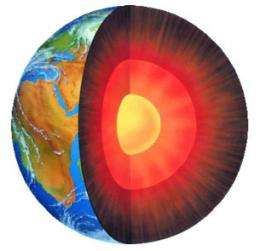Oxygen to the core

(Phys.org)—An international collaboration including researchers from Lawrence Livermore National Laboratory has discovered that the Earth's core formed under more oxidizing condition's than previously proposed.
Through of series of laser-heated diamond anvil cell experiments at high pressure (350,000 to 700,000 atmospheres of pressure) and temperatures (5,120 to 7,460 degrees Fahrenheit), the team demonstrated that the depletion of siderophile (also known as "iron loving") elements can be produced by core formation under more oxidizing conditions than earlier predictions.
"We found that planet accretion (growth) under oxidizing conditions is similar to those of the most common meteorites," said LLNL geophysicist Rick Ryerson.
The research appears in the Jan. 10 edition of Science Express.
While scientists know that the Earth accreted from some mixture of meteoritic material, there is no simple way to quantify precisely the proportions of these various materials. The new research defines how various materials may have been distributed and transported in the early solar system.
As core formation and accretion are closely linked, constraining the process of core formation allows researchers to place limits on the range of materials that formed our planet, and determine whether the composition of those materials changed with time. (Was accretion heterogeneous or homogeneous?)
"A model in which a relatively oxidized Earth is progressively reduced by oxygen transfer to the core-forming metal is capable of reconciling both the need for light elements in the core and the concentration of siderophile elements in the silicate mantle, and suggests that oxygen is an important constituent in the core," Ryerson said.
The experiments demonstrated that a slight reduction of such siderphile elements as vanadium (V) and chromium (Cr) and moderate depletion of nickel (Ni) and cobalt (Co) can be produced during core formation, allowing for oxygen to play a more prominent role.
Planetary core formation is one of the final stages of the dust-to-meteorite-to-planet formation continuum. Meteorites are the raw materials for planetary formation and core formation is a process that leads to chemical differentiation of the planet. But meteorite formation and core formation are very different processes, driven by different heat sources and occurring in very different pressure and temperature ranges.
"Our ability to match the siderophile element signature under more oxidizing conditions allows us to accrete the Earth from more common, oxidized meteoritic materials, such as carbonaceous and ordinary chondrites," Ryerson said.
The earth's magnetic field is generated in the core, and protects the Earth from the solar wind and associated erosion of the atmosphere. While the inner core of the Earth is solid, the outer core is still liquid. The ability to preserve a liquid outer core and the associated magnetic field are dependent on the composition of the core and the concentration of light elements that may reduce the melting temperature.
"By characterizing the chemical interactions that accompany separation of core-forming melts from the silicate magma ocean, we can hope to provide additional constraints on the nature of light elements in the present-day core and its melting/freezing behavior," Ryerson said.
Journal information: Science Express
Provided by Lawrence Livermore National Laboratory












.jpg)







